In the aftermath of the sinking of Eilat, western navies struggled to find solutions to the new threat of anti-ship missiles. Much of the effort focused on electronic countermeasures and missiles, such as the Basic Point Defense Missile System adapted from the air-to-air AIM-7 Sparrow and later known as the RIM-7 Sea Sparrow. But the early versions of Sea Sparrow in particular were rather crude, and the Navy also issued a contract for a last-ditch gun-based point-defense weapon. The result was the ubiquitous Phalanx Close-In Weapons System (CIWS), universally known as "Sea Wizz".
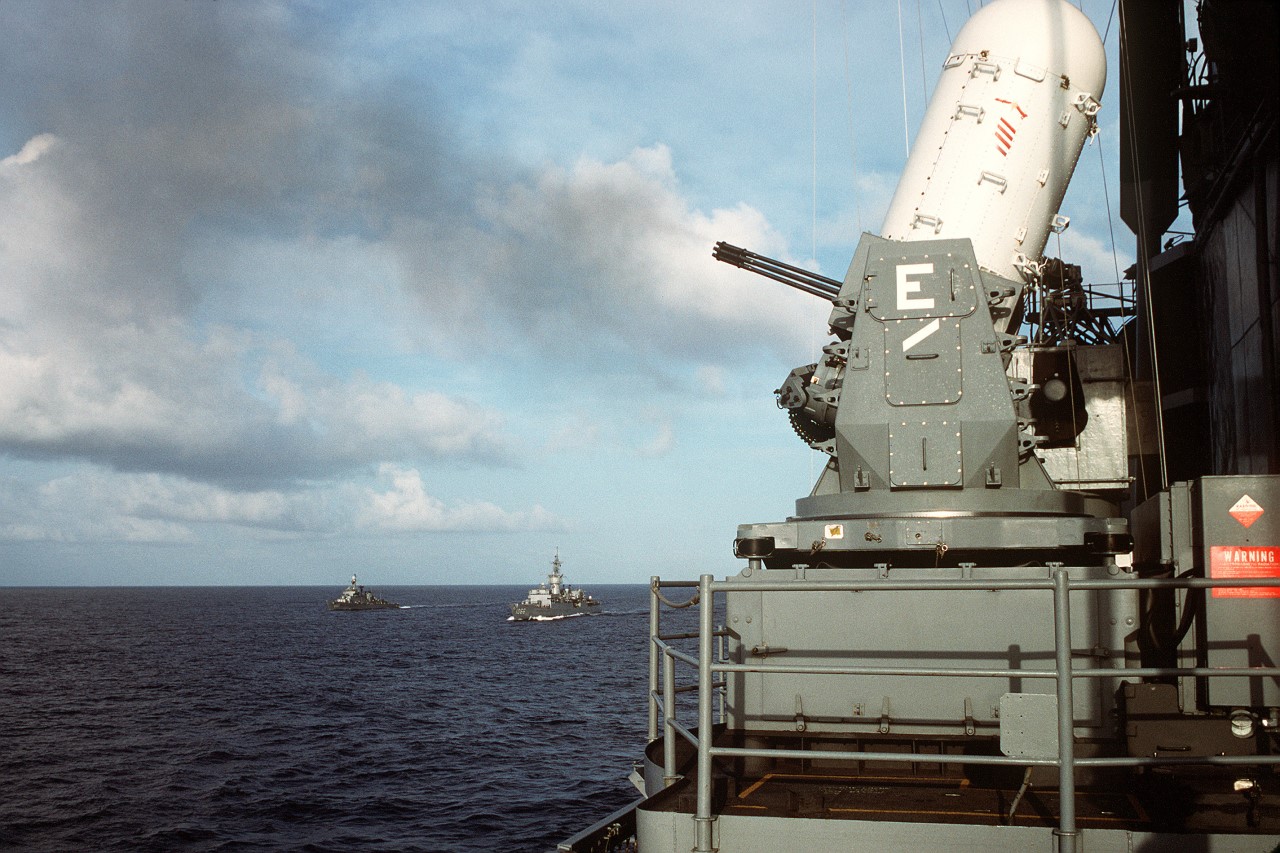
A Phalanx aboard Missouri fires during RIMPAC 90
Because the system was needed in service urgently, the gun selected was the existing M61 Vulcan gatling gun,1 a 20mm weapon with six rotating barrels driven by an external motor. Developed for the Air Force starting in the late 40s, it demonstrated an excellent combination of low weight, high rate of fire, reliability and lethality. By the late 60s, it was America's standard fighter gun, and it remains in service on the F-15, F-16, F/A-18 and F-22 to this day. But the real magic of Phalanx was in the control system. Two radar antennas are fitted inside the dome above the gun, operating in the Ku band. One searches the area around the weapon for threats, while the other tracks potential targets more precisely before firing. This antenna also tracks the outbound bullets, and the control system calculates their closest approach to the target, then adjusts its aim to bring that distance to zero. This technique, known as closed-loop spotting, cuts the time required to bring the weapon on target dramatically and is estimated to increase lethality by an order of magnitude.
This system meant that Phalanx could be entirely automated, requiring only minimal outside intervention, and the designers took advantage of this to create a system that would be easy to add to existing ships, even on short notice. A basic Phalanx installation requires only a clear piece of deck capable of handling the six-ton unit, good visibility, somewhere to put the control console, course information and supplies of power and cooling water. This means it can be fitted to almost any vessel, including auxiliaries, and has seen CIWS aboard more ships than any other major weapon system. It also makes maintenance and upgrades easy, as the entire unit can be unbolted and replaced with another one from a warehouse ashore. Control is fairly straightforward. When on, engagement of hostile-looking targets is fully automated, with a manual override. This usually starts with detection around 6,000 yards, followed by acquisition at 4,600. It then points at the target at approximately 115°/sec, the whole system taking about 3 second to react to a new target appearing. 2,000 yards out, the system opens fire at 3,000 rounds/min, although the 980-round magazine would probably limit it to five or so targets before a manual reload.
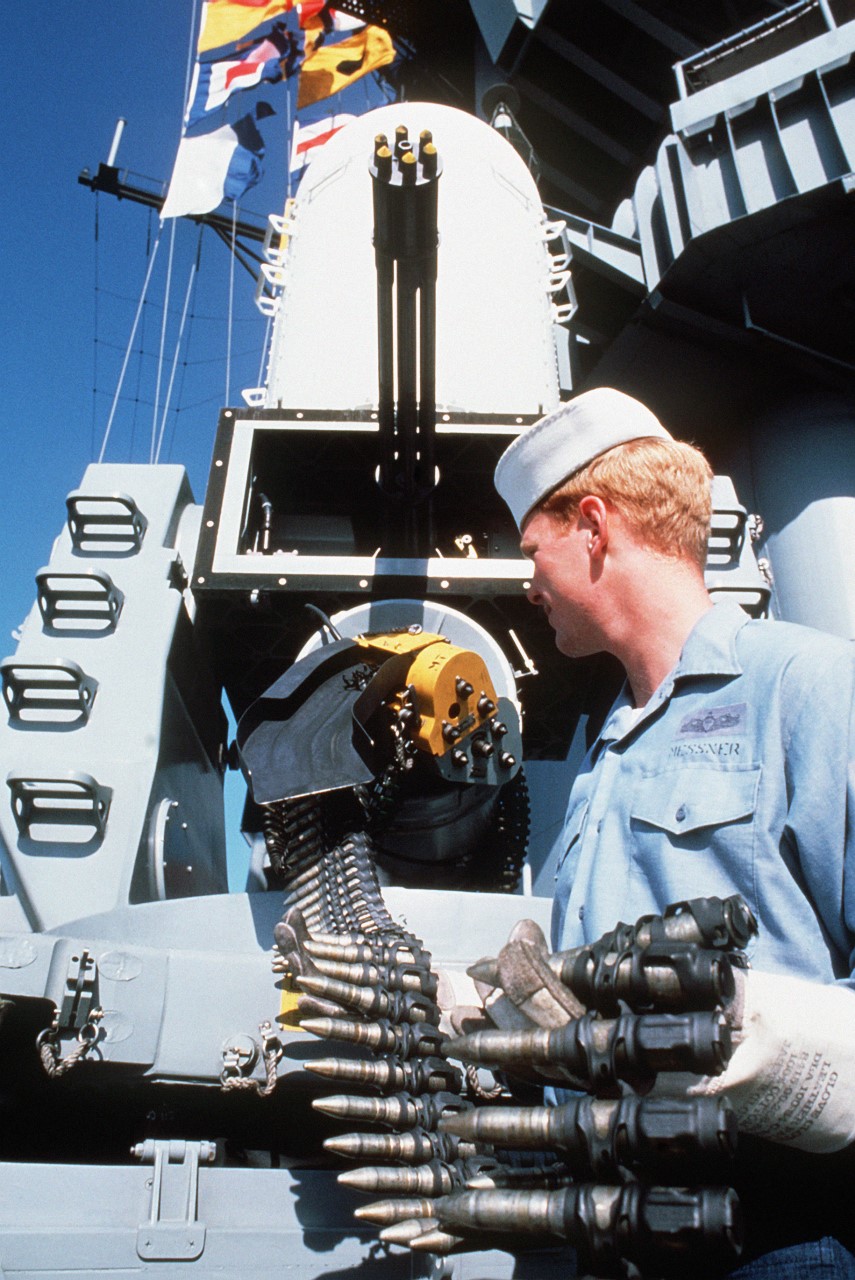
Ammunition is loaded into one of Iowa's CIWS
That magazine is loaded with specialist ammo, too. Instead of a standard 20mm bullet, Phalanx fires a 12.75 mm sub-caliber dart, held in a sabot that drops off after it leaves the muzzle. This lets the gun throw its projectiles faster, with a muzzle velocity of 3,650 ft/sec, and the darts are made of very dense material to make sure that they keep as much of that velocity as possible on the way to the target. Initially, the projectiles were made of depleted uranium, the uranium left over after U-235 is removed to be turned into nuclear bombs. This is extremely dense and quite hard, but also toxic and just radioactive enough to require some care in handling.2 This was annoying enough that the Navy looked for a replacement, and tests showed that a tungsten-based alloy was just as effective, so it has been standard since 1990. Neither the DU nor the tungsten darts have any explosive content, and instead are expected to kill incoming missiles by penetrating the warhead and setting off the fuze. Ammunition was further improved in the late 90s with the Mk 244 round, which had a 50% heavier penetrator and more energetic powder to raise muzzle velocity about 15%.
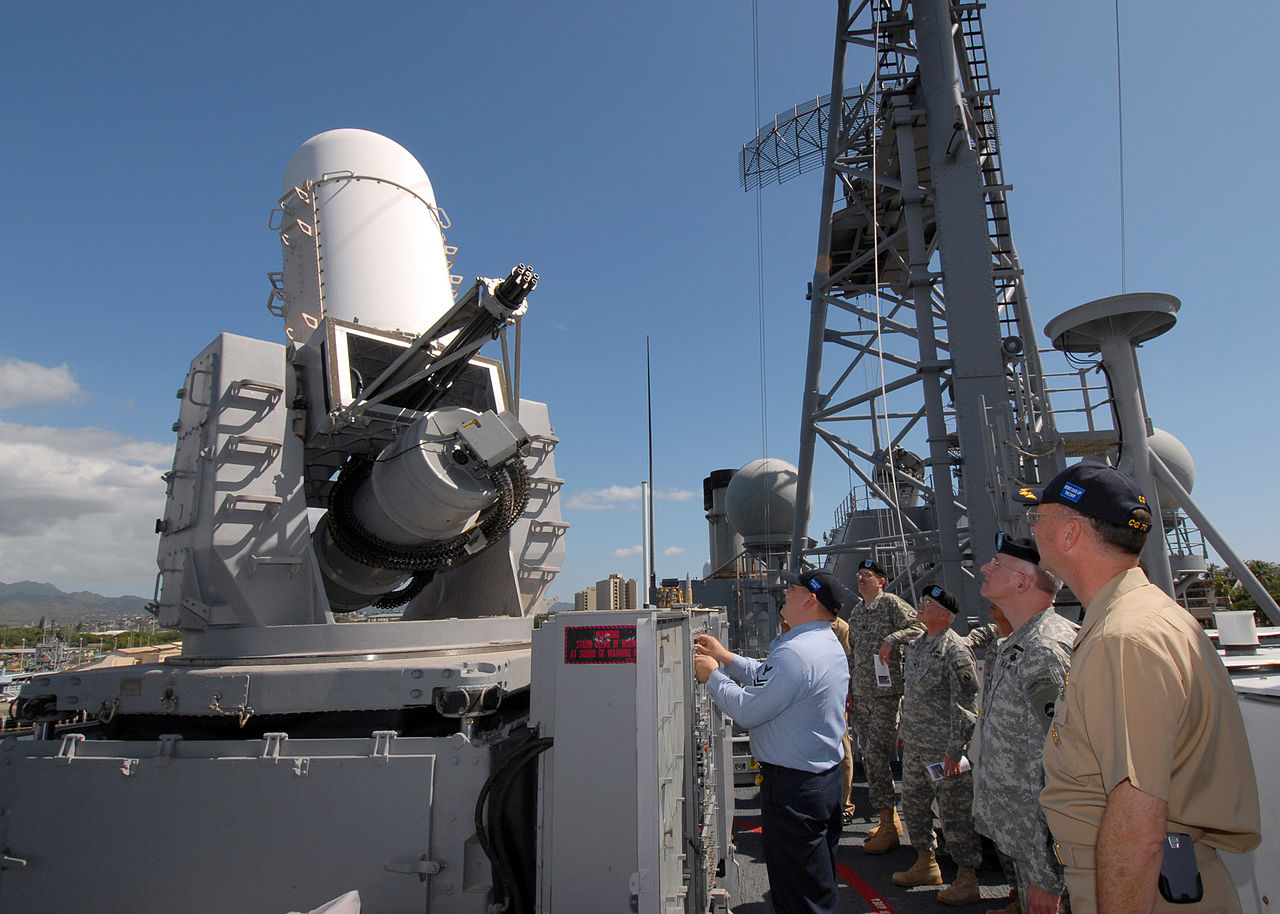
A Block 1 Phalanx
The rest of the system has also seen improvements over the years. The original model, known as Block 0, was largely limited to low-altitude targets, and the first upgrade, Block 1, saw the rotating search radar replaced with a phased array, giving elevation coverage up to 70° and making it much more effective against diving missiles. The new radar also resolves one problem with the doppler function of the original, which was likely to be confused by helicopter blades and think the chopper was coming in much faster than it was. The ammunition drum grew to 1,550 rounds, and a new algorithm was added to cease fire earlier and improve how many targets it could handle before reloading. During tests, this variant proved able to intercept 155mm artillery shells as well as missile targets. This was introduced in the mid-80s, and followed at the end of the decade by Block 1 Baseline 1, which had an improved motor, boosting rate of fire to 4,500 rpm. Block 1A followed in the mid-90s, and had a much faster processor with improved prediction algorithms, which was estimated to double maximum gun range. It also included new features that enabled it to tie into the combat systems of the ship it was mounted on, allowing it to acquire targets faster and more reliably.
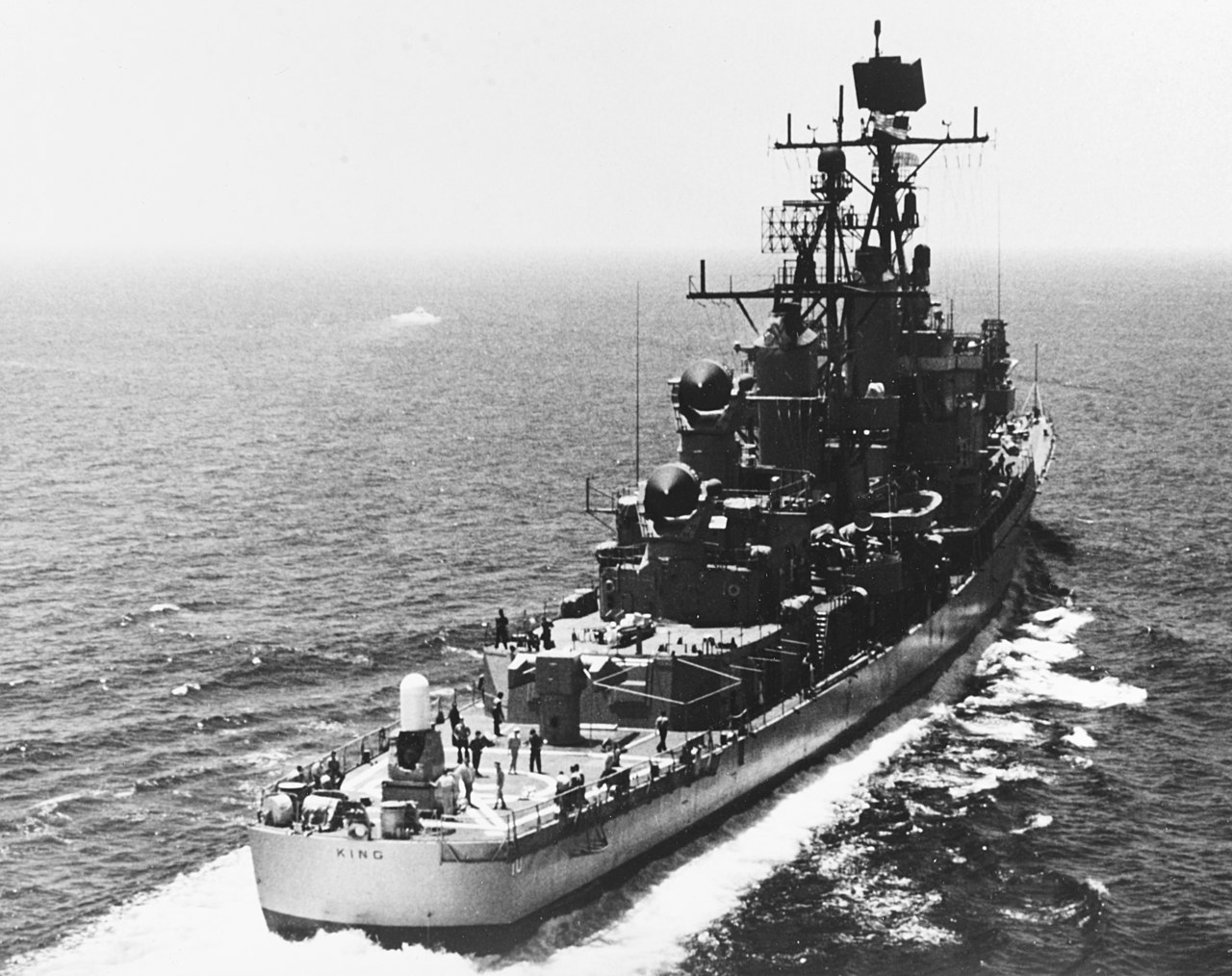
The Phalanx prototype aboard USS King in 1973
Over the years, other missile defense systems have improved, and Phalanx, with its limited range, began to be seen as less useful. Kill range matters because even if the missile is shot down, it doesn't stop instantly, and can still spray the ship with debris and burning fuel. The exact values don't appear to be public information, but the initial specification required a keep-out range of 230 yards, presumably for a subsonic missile. As missiles have gotten faster, this has become more and more of a problem, and the USN has responded by developing weapons capable of meeting incoming ASMs further out, most notably RAM and ESSM. In the late 90s, it looked as though these would replace Phalanx, with the Flight IIA Burkes not even scheduled to receive the system. This changed in the aftermath of the attack on the USS Cole, as attack by small boats suddenly became a major threat, and Phalanx proved perfectly adapted to deal with it. An anti-surface mode, with the weapon firing in manual control, had been available from the start, but it was quite primitive and hard to use.
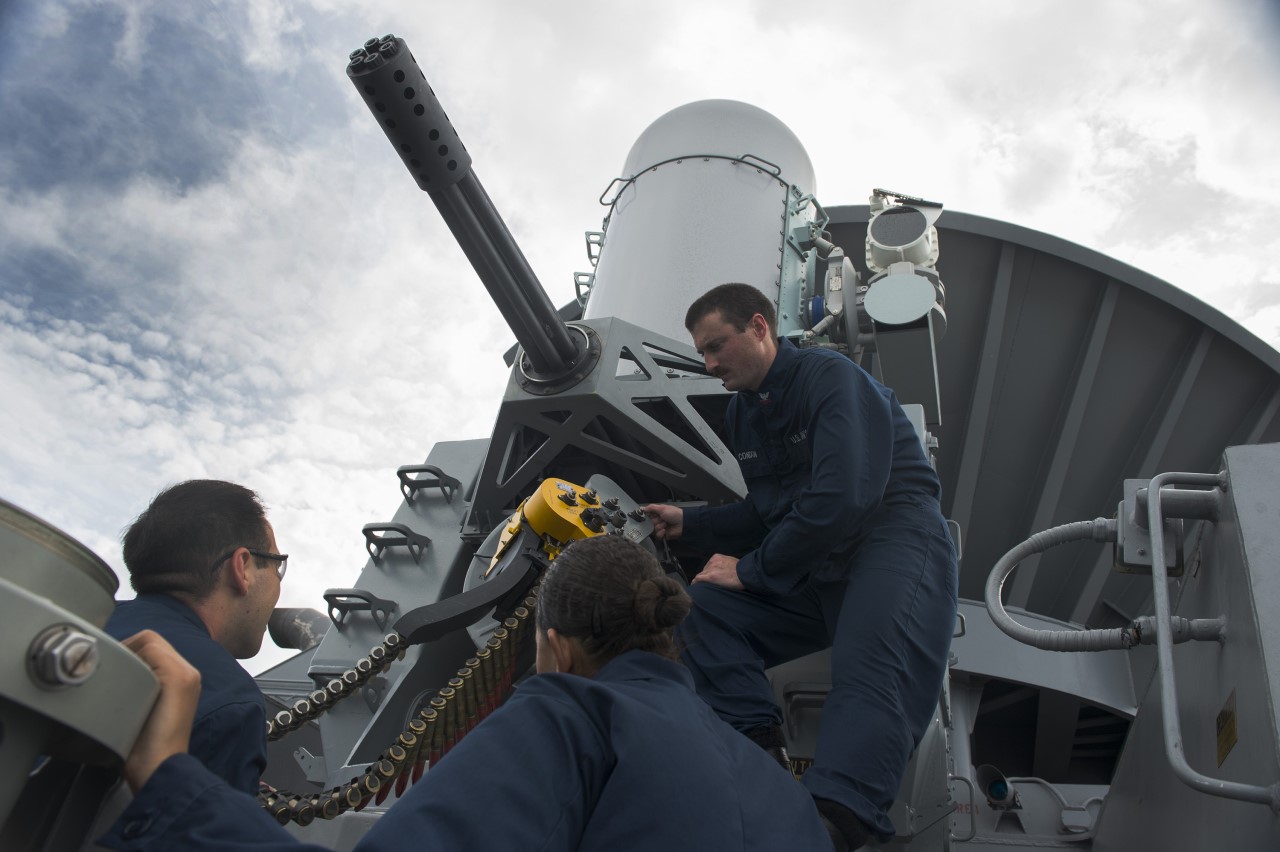
A Block 1B Phalanx aboard USS America is loaded with ammunition
This was solved in the latest version, Block 1B. The most obvious change was the installation of an IR camera that finally gives the operator a good way to find surface targets, and an auto-tracker to improve accuracy against them. When in surface mode, the gun would be limited to 50-round bursts with a gap between them to see if the target had been destroyed. While this was going on, the search radar keeps looking for missiles, ready to shoot them down automatically. The system also got longer gun barrels for better accuracy and higher muzzle velocity (linked to the Mk 244 round). Today, all of the USN's systems have been upgraded to Block 1B.3
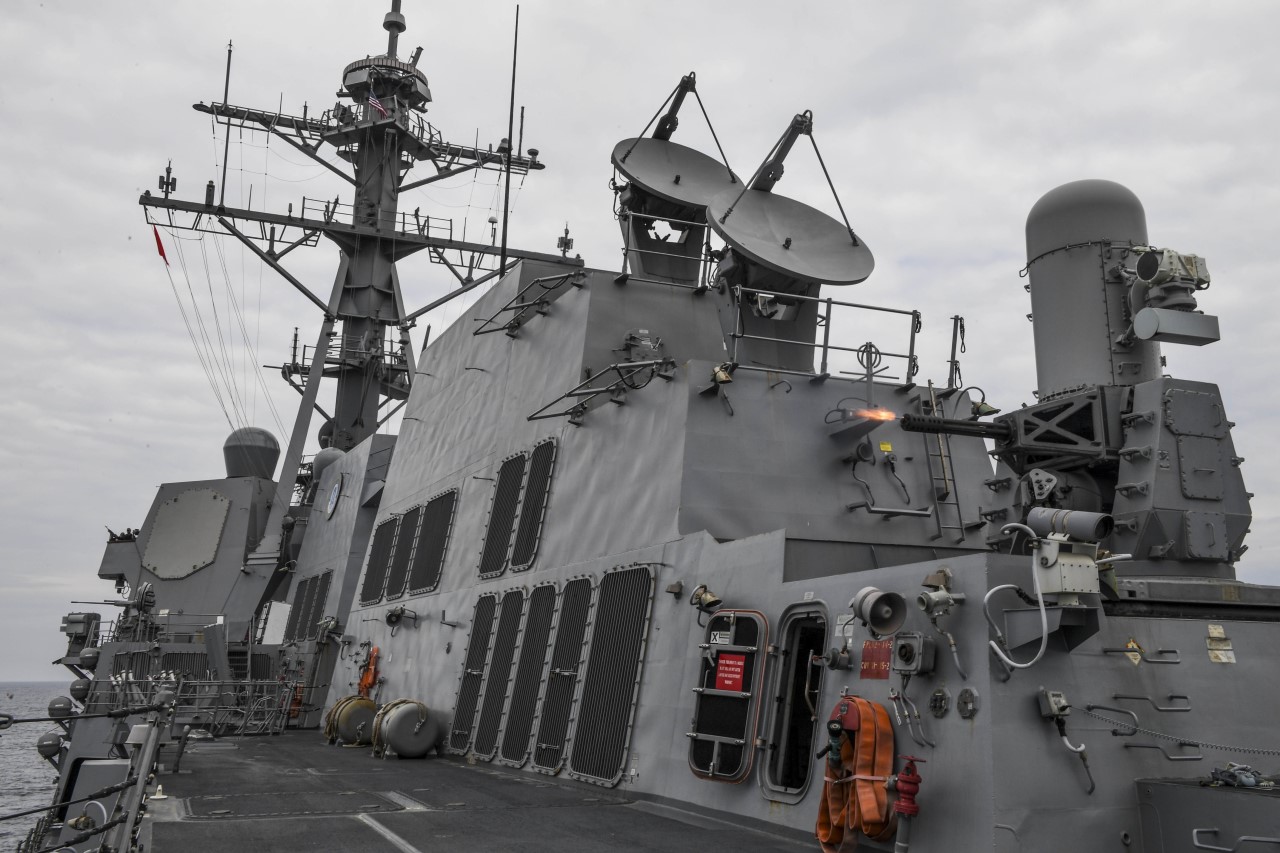
The Phalanx aboard Wayne E Meyer is test-fired
Phalanx is currently in service on most ships of the USN, and on those of many of our allies as well. The record for most Phalanxes on a given ship is still held by the Iowa class, which had four after their reactivation.4 The big carriers were close behind with three each, while most smaller ships, including the LHAs/LHDs, LSDs, Burkes and Ticos have one or two. The Coast Guard has systems aboard some of its larger cutters, and it's been exported to 21 countries, sometimes aboard vessels the US has sold, and sometimes for new construction.
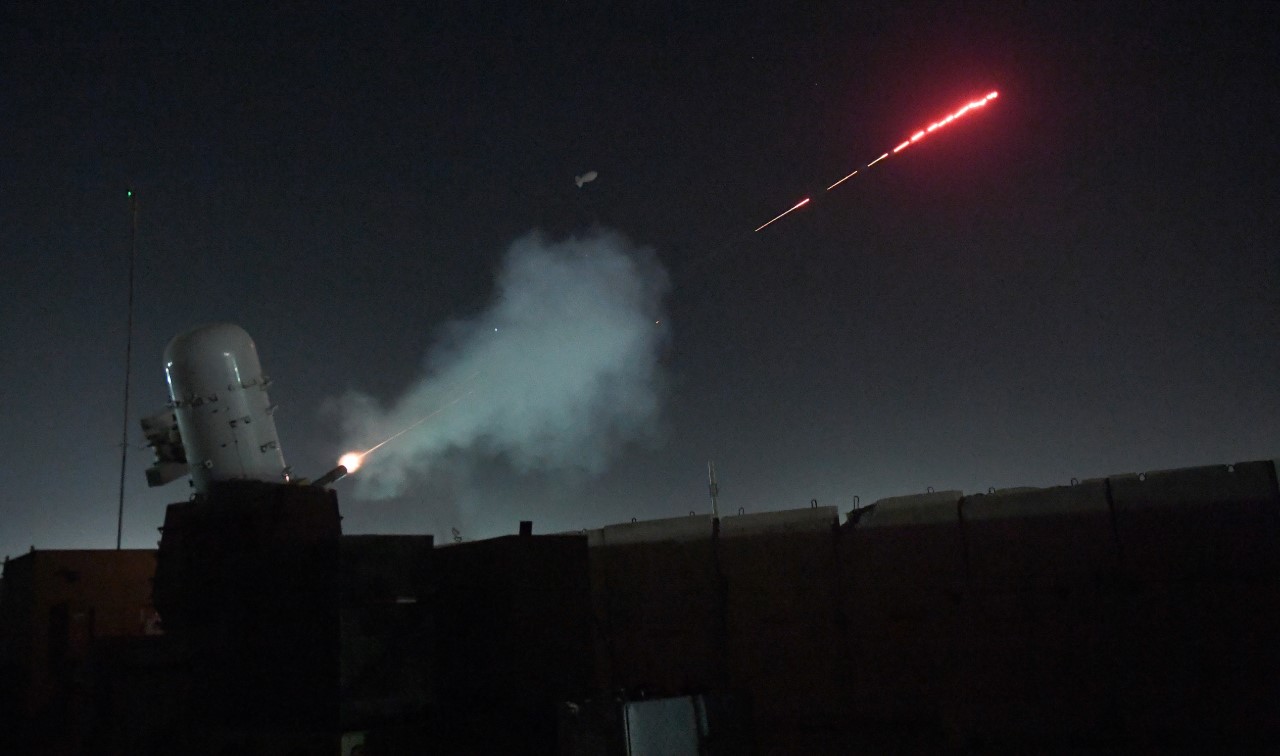
A night C-RAM shoot
The basic Phalanx architecture has proven quite versatile, giving birth to other systems. In 2004, the US Army requested a solution to the problem of rocket and mortar fire on its bases in Iraq, and Raytheon, who makes Phalanx, responded with a version mounted on a trailer and powered by a generator. The biggest difference is in the ammunition. While randomly bombarding the sea with sabot rounds is generally OK, such practices are usually frowned upon when they might be landing on someone's house. As such, this system, known as C-RAM5 uses a high-explosive tracer round that destroys itself when the tracer burns out. C-RAM, integrated with various counterbattery radars, proved itself quite effective in Iraq, with at least 40 systems deployed during the height of US presence there.
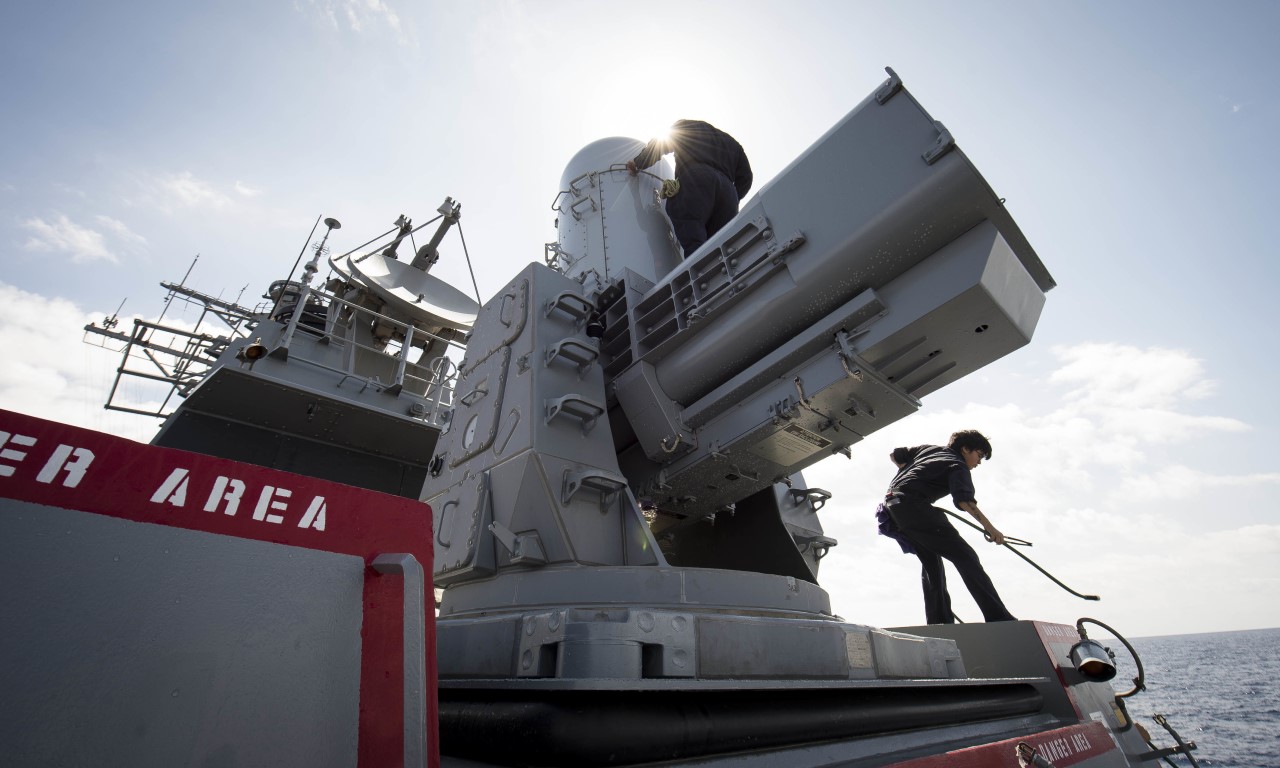
Sailors maintain the SeaRAM aboard USS Porter
Confusingly, the other major descendant of Phalanx is also known as SeaRAM, although, as the name suggests, it is used at sea. SeaRAM is a combination of the CIWS radar and control system with the RIM-116 Rolling Airframe Missile (RAM) to destroy targets at longer range than the normal Phalanx can. Normally, RAM is fired from a 21-round box launcher integrated with the ship's combat system, but SeaRAM removes this requirement, allowing autonomous self-defense with its 11-round box launcher. It was first used aboard the Independence class LCS, and has also been fitted to several destroyers to provide backup self-defense capability while their radars are in ballistic missile defense mode.
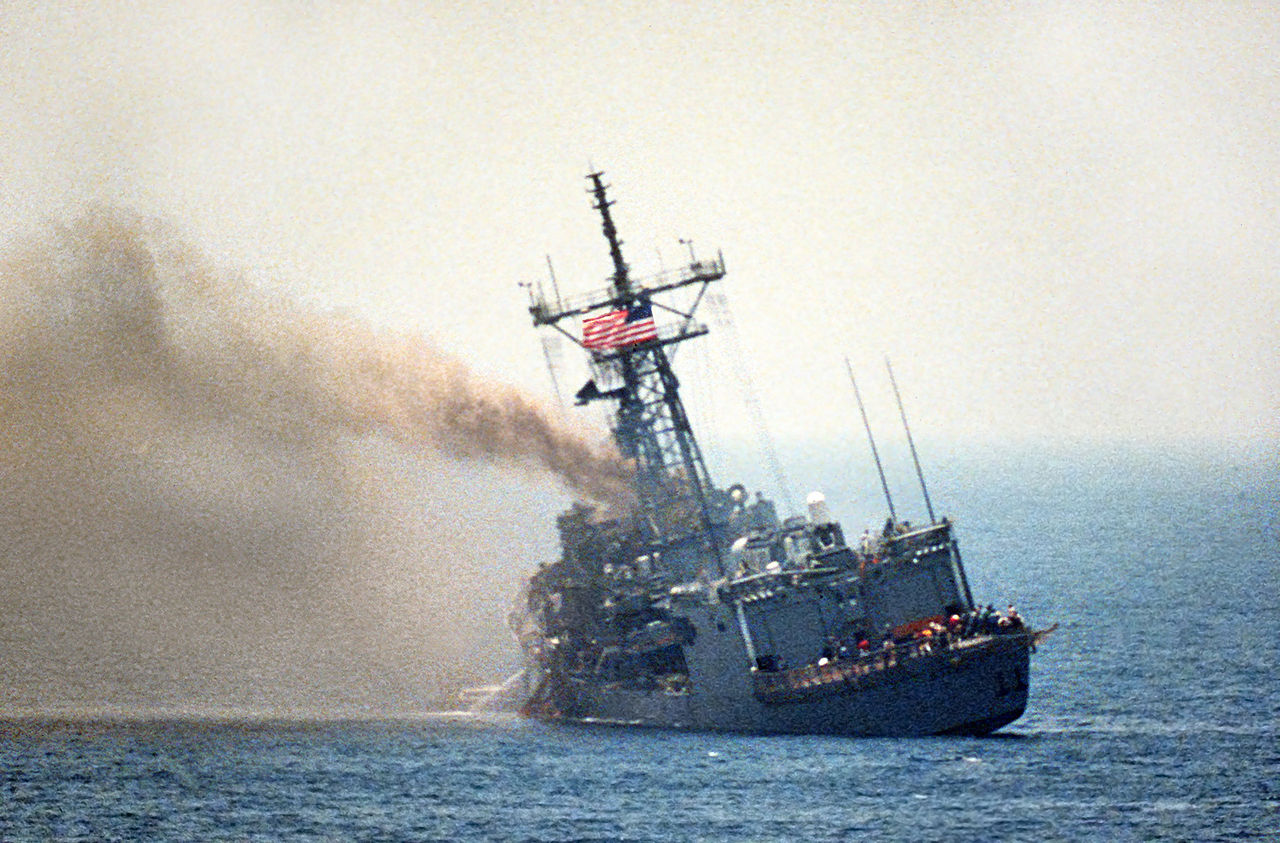
Stark burns after the missile hit
So how as Phalanx held up in combat? Astonishingly for such a widely-deployed system, there are only a handful of cases in which ships equipped with Phalanx have been the subject of missile fire, and it wasn't until 2024 that the system actually shot down a hostile missile. The first case was the frigate Stark, on patrol in the Persian Gulf in 1987 when she was attacked by an Iraqi business jet modified to fire Exocet missiles. Her Phalanx was in standby mode because of the risk of it accidentally attacking something it shouldn't have, and thus did nothing to shoot down either of the Exocets. Both missiles hit, killing a total of 37 sailors, although Stark’s crew was able to control the fires and save the ship. The next test came a few years later and not very far away. Iraq fired two Silkworms at Missouri in February 1991, and while neither of them came close enough to trigger the battleship's CIWS, later analysis showed that Missouri’s Phalanx was tracking and would have engaged had it been a threat. A few hours later,6 tragedy struck, when chaff that she fired in response to another missile warning triggered the Phalanx on the nearby frigate Jarrett. Four rounds struck Missouri, slightly injuring one man. Lastly, destroyers Mason and Nitze were both subject to missile attack off the coast of Yemen in 2016, although none of the missiles got close enough to trigger their Phalanxes. Finally, in February 2024, destroyer Gravely used her CIWS to down an incoming cruise missile in the Red Sea off Yemen, although the only available detail is that it was "within a mile".
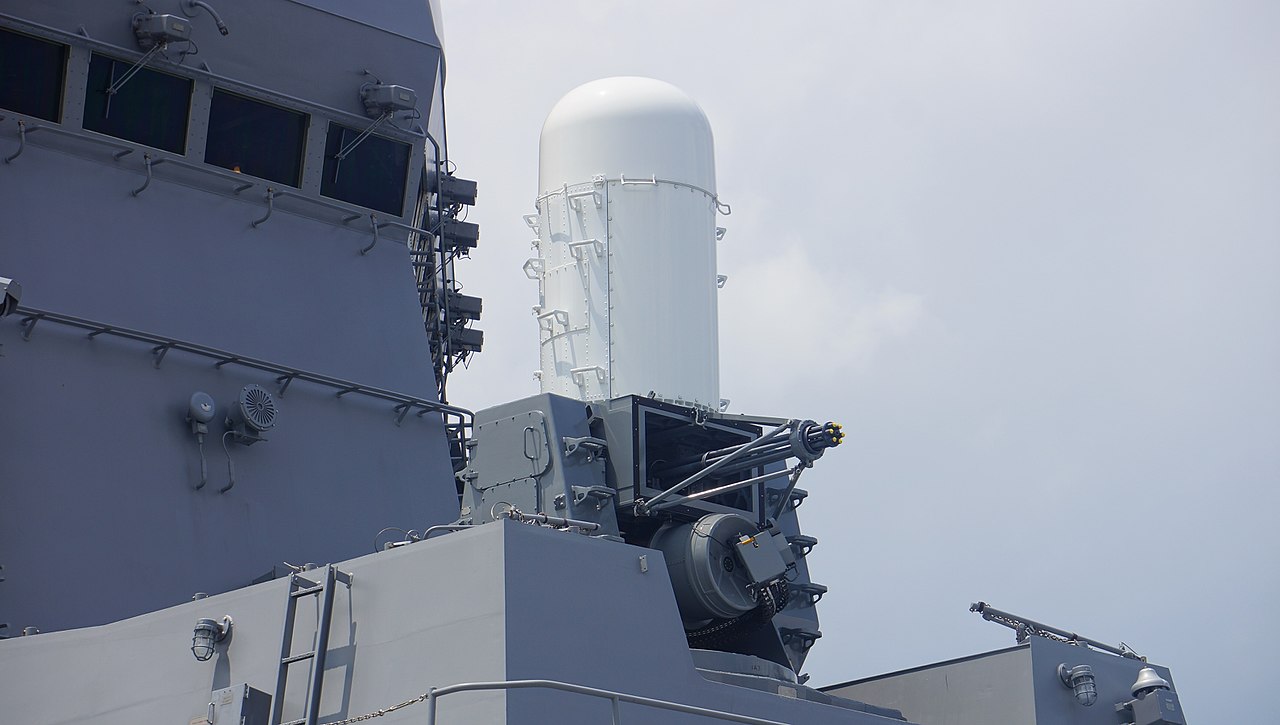
A Phalanx aboard Japanese destroyer Fuyuzuki
The only previous case of a Phalanx shooting something down outside of test/training targets happened in 1996, when Japanese destroyer Yugiri was conducting a practice shoot against a target towed by a USN A-6. Unfortunately, the system's radar locked onto the A-6 instead of the towed target,7 and the operator gave the order to fire before it had cleared the system's envelope. Fortunately, both of the A-6's crew ejected safely, but this incident illustrates the danger Phalanx poses if not used carefully. Despite this downside, the system, known to American crews as R2-D2 and to the British as the Dalek, will remain in service worldwide for many years to come.
1 Early on, the system was known as "Vulcan Phalanx", a name that still pops up from time to time, but is incorrect. ⇑
2 I once met a guest on the Iowa who was on a CGN and his dosimeter badge kept coming back with anomalous radiation on it, which they eventually worked out was from the CIWS above his cabin. It wasn't actually harmful, but it was enough to concern the Navy's regulators. ⇑
3 Jade Nekotenshi has said that he's read that the standard ammo loadout has changed to a 50/50 mix of sabot and explosive for better effect on small boats, although a look through recent pictures of CIWS ammo shows it to be all-sabot. It's possible this is a loadout they only carry in special cases. ⇑
4 This is actually a limitation on the radar system. Too many Phalanxes in close proximity will start interfering with each other. ⇑
5 Counter-Rockets, Artillery and Mortars ⇑
6 Most sources place this as part of the Silkworm attack, but Paul Stilwell, who gave the most detailed account of the incident, has them separate. ⇑
7 Phalanx doesn't use IFF data, the best way of telling friend from foe. ⇑

Comments
The lesson I'm drawing from this, along with the loss of the Sheffield while her ESM system was shut down, is that it doesn't matter how good your missile-defence system is if you don't switch it on. Are these examples just really bad luck, or do warships spend a large fraction of the time with their missile-defence systems switched off, even in an active war zone?
This is 100% true.
Sheffield was just bad luck. The ESM system was shut down so they could use the Satcom, and that had to happen at some point. (Well, bad luck and stupid politics, but the politics happened long before.) Stark is more complicated. They were only sort of in a war zone, and IIRC, NTDS had the shooter flagged as a friendly because they were more worried about Iran than Iraq.
See also the INS Hanit, damaged by an antiship missile in 2006 because the Israelis didn't believe Hezbollah had antiship missiles in 2006. Concerns with electromagnetic interference and false alarms with this sort of system are legitimate, but ultimately, yeah, it doesn't work unless you turn it on ahead of time.
Also, a nit: I don't think the expected kill mechanism is "setting off the fuze" of the warhead, which is too small and uncertain a target. Rather, the warhead is to be directly detonated by the shock effect of a DU or tungsten projectile hitting the main charge at 1100 m/s. Insensitive munitions are a thing, but there are limits.
Friedman was pretty clear on the fuze issue in both US Naval Weapons and World Naval Weapons, and I believe I found similar things from other sources. I'm not saying that he's never wrong, but it was brought up in certain contexts (like vs Goalkeeper) where it seems unlikely to be a mistake. As for warheads being set off, note that typical detonation velocities for explosives are 5 km/s and up, while the maximum possible impact velocity for CIWS rounds is barely half that even for the fastest ASMs.
I'm confused on the value of shooting at 1500 rounds/min. Can the aiming system really react that quickly? Or are there imperfections that mean there's a hail of bullets around the aim point similar to a shotgun, so shooting faster means a wider 'spread'? What would happen to the PK if they slowed down to, say, 300 rounds/min and thus gained the ability to engage 25 targets before reload instead of 5?
Yes, all evidence I have says that it can react that quickly. Anecdotal evidence says that they generally expect a hit on the third round, although I suspect that's somewhat optimistic. The issue is just that they're trying to hit the fuze, which is a pretty small target within the missile, which in turn means that you're going to want as many shots as you can get. For that reason, dropping ROF won't really increase Pk, and definitely won't save ammo. I think at least the more recent versions actually have predictive "we've shot enough for a kill" algorithms which should save some ammo.
Not an expert, but I expect that you're trying to fill a volume that the missile will fly through with a sufficient density of projectiles that it will hit enough to kill it. Reducing the number of projectiles would reduce the density (or perhaps the volume?) and give the missile more of a chance of getting through. Even if you wanted to reduce the number of rounds used, you might want to still fire them at a high rate, to keep up the density of projectiles.
The other advantage of the high ROF is the ability to quickly aim-correct while firing. Most gun CIWS systems use a high rate of fire, so I'd expect that if lowering the ROF without using a much larger round were an optimal strategy, someone else would be doing it.
There is one system - Meroka - that uses a bunch of single-chamber barrels (a volley gun) to fire quick bursts at an extremely high rate, mostly for density. Meroka's overall rate of fire is lower than Phalanx, but the density is higher. That said, I don't see any other CIWS that uses a volley gun. Pretty much everything except DARDO, 76mm STRALES and Sea Zenith use gatling guns. Sea Zenith uses four barrels for a similar effect, while DARDO and STRALES use at least VT-fuzed ammo. (STRALES has guided rounds too, at least, according to the marketing materials.)
Also, regarding the Wasps - at least initially, they had 3 Phalanx mounts, although I think that one of those has been exchanged for RAM now. (In 2002, Wasp had 2x NSSM, 1x RAM, 3x Phalanx; I think they're all 2/2/2 now.)
America is 2/2/2, and Polmar confirms that the Wasps are the same now.
Good to know, that makes more sense than the old config - there were two Phalanx mounts aft, on either side of the Sea Sparrow launcher, and it kinda made me scratch my head, since the forward Phalanx could cover the same arc as one of the aft ones, but the forward RAM can't fire astern (unless it can fire over the shoulder, which I'm not sure about - the addition of a RAM launcher aft makes me think not, or at least not reliably).
Like John, I'm dubious about Phalanx needing to actually hit the fuze. If that were the case ... armoring an entire missile against 12.75 mm darts is obviously impractical, but armoring just the fuze, against rounds coming from the front only, wouldn't add that much to the weight of the missile.
Perhaps the rounds just have to hit somewhere in the warhead assembly, and the shock of the impact sets off the fuze? But you could protect against that, too, by mechanically isolating the fuze.
I don't think you could actually armor the fuze, because it still has to function as a fuze. You're going to want to put the fuze at the back of the warhead so the ASM can penetrate into the target. So you can't really armor the fuze without cutting it off from the warhead.
I seem to recall reading that some Soviet ASMs were "armored" to one extent or another. I think this was mostly a thick cap on the front of the warhead, probably as much to give it some penetration capability when combined with a time-delay base fuze, though it probably incidentally protected against CIWS fire to a point.
At least initially, they did have some armored ships to worry about - the various cruisers, Essex and Midway-class carriers (*) - so SAP warheads make sense. I'm not sure if that was the main intent, or if it was actually meant to be armor.
Unless I've seriously got my history sideways, I think these armored/SAP warheads predate Phalanx and Goalkeeper, but I'm not sure if they predate the USSR's AK-630, which IIRC came first. I do wonder if Italy's preference for CIWS that fire proximity-fuzed rounds that would likely pepper the sides of a missile and either disintegrate the airframe or destabilize its flight path, as opposed to hitting the nose, comes from their own use of an SAP warhead on OTOMAT/Teseo?
Also, an amendment to my earlier post - I can think of one other CIWS that doesn't use a gatling gun (assuming we don't count the Mk 110 57mm as a CIWS): the Millennium gun system. That's a 35mm gun that uses time/proximity-fuzed ammo, but it is a revolver cannon, so it's most of the way to a gatling. It's understandable why they wouldn't have wanted to build a gatling 35mm - that'd be a hungus of a gun, bigger than GAU-8 or GSh-6-30, which are already pretty mahoosive for their caliber.
(*) - A lot of anecdotes claim the Forrestals and Kitty Hawks have armor of some kind, but tend to be rather sparse on how much or where - I'm guessing they just have a fairly thick steel deck and some splinter protection. Does anyone know for sure?
Most ASMs have SAP warheads (including, for instance, Harpoon), although obviously some are bigger and more AP than others. The bigger Russian ones may be carrier-driven, but I think most of it is just that you really want the missile inside the ship, and don't want it blocked if it happens to hit some piece of equipment instead of just the hull. But I think these will be of limited effectiveness, as one of the main reasons for the exciting sabot rounds on Phalanx is to make sure that they can penetrate the SAP caps.
Re carrier armor, I'd heard that too, but Friedman gives only 80 tons of protection on Forrestal, which isn't nearly enough for any sort of reasonable armor. The flight deck is the strength deck, so it's thick for structural reasons more than armor, but that doesn't mean it won't stop missiles.
bean:
What would that little protect?
Probably just the magazines. Maybe even only the nuclear magazines, because 80 tons really isn't a lot.
Is there some way to estimate shock sensitivity or does it depend too much on subtle physical properties and reaction constants?
Using the activation energies and something like Rankine Hugoniot.
Don't know. My only explosives class was fireworks. But I have a friend who took more, and I could ask him.
(No, none of this is a joke.)
Have you done a post on IFF systems? Seems like an interesting topic (in particular: how do you avoid enemies pretending to be friendly?), and your mention of it above twigged my curiousity.
Thanks.
Lambert: According to John Clark's Ignition (a rocket design history book), they'd do "card gap" tests on rocket fuels to estimate shock sensitivity, which gave pretty good measures for most purposes. Basically, you put a small explosion near a sample, and measure how many acetate cards you need to stick between the two for the sample not to go off sympathetically.
There's forms of shock sensitivity not measured by that - apparently, one or two were liquids that were extremely sensitive to cavitation-type bubbles forming and collapsing within them, for example - but it was the one they settled on as an all-around test. They didn't bother with theoretical estimates, other than as a rough guideline to whether it was worth even trying to make a sample of, or to laugh at the advice from 1960s computers telling them to make impossibly sensitive compounds to get a 3% increase in performance.
I haven't talked about IFF systems. Spoofing is always a concern with things like that, and modern systems make use of cryptography to try to prevent it. I don't really know much beyond "there's a key and anyone who has that key should be friendly". Of course, that doesn't always work. There's the infamous "MiG in the middle" attack, reportedly used by the Cubans against South Africa in Namibia. A flight of MiGs attempting to penetrate South African air defenses relayed the IFF challenge to an Angolan air-defense battery, who then sent it to South African bombers on a raid. They responded, and the response was relayed back to the MiGs, who looked like friendlies to the South Africans.
Was that the same MiGs recieving the challenge and transmitting the response? I'm tremendously impressed if they could communicate that quickly, because I would have expected it to take hours at best to arrange something like that, and perhaps long enough that you might worry the codes would have changed.
They were reportedly doing this in real-time. It's just a set of radio transponders linked up so that the ground station is listening for the signal from the MiG and there's a retransmitter on the MiG waiting for the correct code from the ground.
The tricky part, I think, would be ensuring that there's a South African bomber raid happening at the same time. Perhaps the MiGs were on standby, waiting for the opportunity?
Hey Bean!
You state that the record for most phalanxes is held by the Iowa class, but you don't state what it is. Is it still a matter of security, or did you put the number elsewhere in the article and I can't find it? I assume its four, but I am not certain and I hoped you would know.
Quote below:
The record for most Phalanxes on a given ship is still held by the Iowa class after their reactivation, The big carriers were close behind with three each,
It's four. No secret involved, just me not writing very clearly.